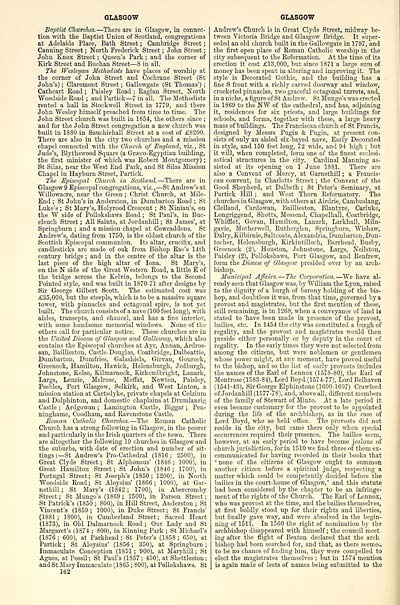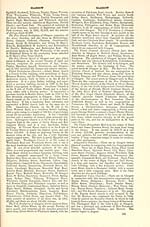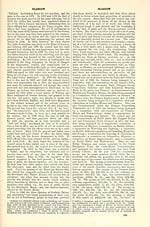Ordnance gazetteer of Scotland > Volume 3
(232) Page 162
Download files
Complete book:
Individual page:
Thumbnail gallery: Grid view | List view

GLASGOW
GLASGOW
Baptist Uliurches. — There are in Glasgow, in connec-
tion with the Baptist Union of Scotland, congregations
at Adelaide Place, Bath Street ; Cambridge Street ;
Canning Street ; North Frederick Street ; John Street ;
John Knox Street ; Queen's Park ; and the corner of
Kirk Street and Buchan Street — 8 in all.
The Wesleyan Methodists have places of worship at
the comer of John Street and Cochrane Street (St
John's) ; Claremont Street ; Gallowgate (St Thomas') ;
Cathcart Road ; Paisley Road ; Raglan Street, North
Woodside Road ; and Partick — 7 in all. The Methodists
rented a hall in Stockwell Street in 1779, and there
John Wesley himself preached from time to time. The
John Street church was built in 1854, the others since ;
and for the John Street congregation a new church was
buOt in 1880 in Sauchiehall Street at a cost of £8200.
There are also in the city two churches and a mission
chapel connected with the Church of England, viz. , St
Jude's, Blythswood Square (a Gra3co-Egyptian building,
the first minister of which was Robert Montgomery) ;
St Silas, near the West End Park, and St Silas Mission
Chapel in Hayburn Street, Partick.
The Episeo2>al Church in Scotland. — There are in
Glasgow 9 Episcopal'congregations, viz. , — St Andrew's at
Willowacre, near the Green ; Christ Church, at Mile-
End ; St John's in Anderston, in Dumbarton Road ; St
Luke's ; St Mary's, Holyrood Crescent ; St NLnian's, on
the W side of Pollokshaws Road ; St Paul's, in Buc-
cleuch Street ; All Saints, at JordanhiU ; St James', at
Springburn ; and a mission chapel at Cowcaddens. St
Andrew's, dating from 1750, is the oldest church of the
Scottish Episcopal communion. Its altar, crucifix, and
candlesticks are made of oak from Bishop Rae's 14th
century bridge ; and in the centre of the altar is the
last piece of the high altar of lona. St Mary's,
on the N side of the Great Western Road, a little E of
the bridge across the Kelvin, belongs to the Second
Pointed style, and was built in 1870-71 after designs by
Sir George Gilbert Scott. The estimated cost was
£35,000, but the steeple, which is to be a massive square
tower, with pinnacles and octagonal spire, is not yet
built. The church consists of a nave (100 feet long), with
aisles, transepts, and chancel, and has a fine interior,
with some handsome memorial windows. None of tlie
others call for particular notice. These churches are in
the United Dioeese of Glasgow and Galloway, which also
contains the Episcopal churches at Ayr, Annan, Ardros-
san, Baillieston, Castle-Douglas, Coatbridge, Dalbeattie,
Dumbarton, Dumfries, Galashiels, Girvan, Gourock,
Greenock, Hamilton, Hawick, Helensburgh, Jedburgh,
Johnstone, Kelso, Kilmarnock, Kirkcudbright, Lanark,
Largs, Lenzie, Melrose, Moffat, Newton, Paisley,
Peebles, Port Glasgow, Selkirk, and West Linton, a
mission station at Cartsdyke, private chapels at Colzivim
and Dolphinton, and domestic chaplains at Drumlanrig
Castle ; Ardgowan ; Lamington Castle, Biggar ; Pen-
ninghame, Coodham, and Ravenstone Castle.
Roman Catholic Churches. — The Roman Catholic
Church has a strong following in Glasgow, in the poorer
and particularly in the Irish quarters of the town. There
are altogether the following 19 churches in Glasgow and
the suburbs, with date of erection and number of sit-
tings :— St Andrew's Pro-Cathedral (1816 ; 2500), in
Great Clyde Street ; St Alphonsus' (1846 ; 1000), in
Great Hamilton Street ; St John's (1846 ; 1700), in
Portugal Street; St Joseph's (1850; 1200), in North
Woodside Road; St Aloysius' (1866; 1000), at Gar-
nethill ; St Mary's (1842 ; 1700), in Aberoromby
Street ; St Mungo's (1869 ; 1500), in Parson Street ;
St Patrick's (1850 ; 800), in Hill Street, Anderston ; St
Vincent's (1859; 1000), in Duke Street; St Francis'
(1881; 1800), in Cumberland Street; Sacred Heart
(1873), in Old Dalmarnock Road ; Our Lady and St
Margaret's (1874 ; 800), in Kinning Park ; St Michael's
(1876 ; 600), at Parkhead ; St Peter's (1858 ; 650), at
Partick ; St Aloysius' (1856 ; 350), at Springburn ;
Immaculate Conception (1851 ; 900), at Maryhill ; St
Agnes, at Possil; St Paul's (1857; 450), at Shettleston;
and St Mary Immaculate (1865 ; 800), at Pollokshaws. St
162
Andrew's Church is in Great Clyde Street, midway be-
tween Victoria Bridge and Glasgow Bridge. It super-
seded an old church built in the Gallowgate in 1797, and
the first open place of Roman Catholic worship in the
city subsequent to the Reformation. At the time of its
erection it cost £13,000, but since 1871 a lai-ge sum of
money has been spent in altering and improving it. The
style is Decorated Gothic, and the building has a
fine S front with a richly carved doorway and window,
crocketed pinnacles, two gi-aceful octagonal turrets, and,
in a niche, a figure of St Andrew. St Mungo's was erected
in 1869 to the NW of the cathedral, and has, adjoining
it, residences for six priests, and large buildings for
schools, and forms, together with these, a large heavy
mass of buildings. The Franciscan church of St Francis,
designed hy Messrs Pugin & Pugin, at present con-
sists of only an aisled six-bayed nave. Early Decorated
in style, and 150 feet long, 72 -nide, and 94 high ; but
it will, when completed, form one of the finest ecclesi-
astical structures in the city. Cardinal Manning as-
sisted at its opening on 1 June 1881. There are
also a Convent of Mercy, at GarnethiU ; a Francis-
can convent, in Charlotte Street ; the Convent of the
Good Shepherd, at Dalbeth ; St Peter's Seminary, at
Partick Hill ; and West Thorn Reformatory. The
churches in Glasgow, with others at Airdrie, Cambuslang,
Clelland, Cardowan, Baillieston, BlantjTC, Carluke,
Longriggend, Shotts, Mossend, Chapelhall, Coatbridge,
WhifBet, Govan, Hamilton, Lanark, Larkhall, Miln-
gavie, Motherwell, Rutherglen, Springburn, Wishaw,
Dairy, Kilbirnie, Saltcoats, Alexandria, Dumbarton, Dun-
tocher, Helensburgh, Kirkintilloch, Barrhead, Busby,
Greenock (2), Houston, Johnstone, Largs, Neilston,
Paisley (2), Pollokshaws, Port Glasgow, and Renfrew,
form the Diocese of Glasgoio presided over by an arch-
bishop.
Municipal Affairs. — Tlie Corporation. — We have al-
ready seen that Glasgow was, by William the Lyon, raised
to the dignity of a burgh of barony holding of the bis-
hop, and doubtless it was, from that time, governed by a
provost and magistrates, but the fii'st mention of these,
still remaining, is in 1268, when a conveyance of land is
stated to 'have been made in presence of the provost,
bailies, etc. In 1454 the city was constituted a burgh of
regality, and the provost and magistrates would then
preside either personally or by deputy in the court of
regality. In the early times they were not selected from
among the citizens, but were noblemen or gentlemen
whose power might, at any moment, have proved useful
to the bishop, and so tlie list of early provosts includes
the names of the Earl of Lennox (1578-80), the Earl of
Montrose (1583-84), Lord Boyd (1574-77), Lord Belhaven
(1541-43), Sir George Elphinstone (1600-1607) Crawford
of Jordanhill (1577-78), and, above all, difl'erent members
of the family of Stewart of Minto. At a late period it
even became customary for the provost to be appointed
during the life of the archbishop, as in the case of
Lord Boyd, who so held office. The provosts did not
reside in the city, but came there only when special
occurrences required their presence. The bailies seem,
however, at an earlj' period to have become jealous of
church jurisdiction, for in 1510 we find three of them ex-
communicated for having recorded in their books that
' none of the citizens of Glasgow ought to summon
another citizen before a spiritual judge, respecting a
matter which could be competently decided before the
bailies in the court-house of Glasgow, ' and this statute
had been considered by the chapter to be an infringe
ment of the rights of the Church. The Earl of Lennox,
who was provost at the time, and the bailies themselveS;
at first boldly stood up for their rights and liberties
but finally gave way, and were absolved in the begin^
ning of 1511. In 1560 the right of nomination by th
archbishop disappeared with himself; the council meet
ing after the flight of Beaton declared that the arch
bishop had been searched for, and that, as there seemeu
to be no chance of finding him, they were compelled to
elect the magistrates themselves ; but in 1574 mention
is again made of leets of names being submitted to the
GLASGOW
Baptist Uliurches. — There are in Glasgow, in connec-
tion with the Baptist Union of Scotland, congregations
at Adelaide Place, Bath Street ; Cambridge Street ;
Canning Street ; North Frederick Street ; John Street ;
John Knox Street ; Queen's Park ; and the corner of
Kirk Street and Buchan Street — 8 in all.
The Wesleyan Methodists have places of worship at
the comer of John Street and Cochrane Street (St
John's) ; Claremont Street ; Gallowgate (St Thomas') ;
Cathcart Road ; Paisley Road ; Raglan Street, North
Woodside Road ; and Partick — 7 in all. The Methodists
rented a hall in Stockwell Street in 1779, and there
John Wesley himself preached from time to time. The
John Street church was built in 1854, the others since ;
and for the John Street congregation a new church was
buOt in 1880 in Sauchiehall Street at a cost of £8200.
There are also in the city two churches and a mission
chapel connected with the Church of England, viz. , St
Jude's, Blythswood Square (a Gra3co-Egyptian building,
the first minister of which was Robert Montgomery) ;
St Silas, near the West End Park, and St Silas Mission
Chapel in Hayburn Street, Partick.
The Episeo2>al Church in Scotland. — There are in
Glasgow 9 Episcopal'congregations, viz. , — St Andrew's at
Willowacre, near the Green ; Christ Church, at Mile-
End ; St John's in Anderston, in Dumbarton Road ; St
Luke's ; St Mary's, Holyrood Crescent ; St NLnian's, on
the W side of Pollokshaws Road ; St Paul's, in Buc-
cleuch Street ; All Saints, at JordanhiU ; St James', at
Springburn ; and a mission chapel at Cowcaddens. St
Andrew's, dating from 1750, is the oldest church of the
Scottish Episcopal communion. Its altar, crucifix, and
candlesticks are made of oak from Bishop Rae's 14th
century bridge ; and in the centre of the altar is the
last piece of the high altar of lona. St Mary's,
on the N side of the Great Western Road, a little E of
the bridge across the Kelvin, belongs to the Second
Pointed style, and was built in 1870-71 after designs by
Sir George Gilbert Scott. The estimated cost was
£35,000, but the steeple, which is to be a massive square
tower, with pinnacles and octagonal spire, is not yet
built. The church consists of a nave (100 feet long), with
aisles, transepts, and chancel, and has a fine interior,
with some handsome memorial windows. None of tlie
others call for particular notice. These churches are in
the United Dioeese of Glasgow and Galloway, which also
contains the Episcopal churches at Ayr, Annan, Ardros-
san, Baillieston, Castle-Douglas, Coatbridge, Dalbeattie,
Dumbarton, Dumfries, Galashiels, Girvan, Gourock,
Greenock, Hamilton, Hawick, Helensburgh, Jedburgh,
Johnstone, Kelso, Kilmarnock, Kirkcudbright, Lanark,
Largs, Lenzie, Melrose, Moffat, Newton, Paisley,
Peebles, Port Glasgow, Selkirk, and West Linton, a
mission station at Cartsdyke, private chapels at Colzivim
and Dolphinton, and domestic chaplains at Drumlanrig
Castle ; Ardgowan ; Lamington Castle, Biggar ; Pen-
ninghame, Coodham, and Ravenstone Castle.
Roman Catholic Churches. — The Roman Catholic
Church has a strong following in Glasgow, in the poorer
and particularly in the Irish quarters of the town. There
are altogether the following 19 churches in Glasgow and
the suburbs, with date of erection and number of sit-
tings :— St Andrew's Pro-Cathedral (1816 ; 2500), in
Great Clyde Street ; St Alphonsus' (1846 ; 1000), in
Great Hamilton Street ; St John's (1846 ; 1700), in
Portugal Street; St Joseph's (1850; 1200), in North
Woodside Road; St Aloysius' (1866; 1000), at Gar-
nethill ; St Mary's (1842 ; 1700), in Aberoromby
Street ; St Mungo's (1869 ; 1500), in Parson Street ;
St Patrick's (1850 ; 800), in Hill Street, Anderston ; St
Vincent's (1859; 1000), in Duke Street; St Francis'
(1881; 1800), in Cumberland Street; Sacred Heart
(1873), in Old Dalmarnock Road ; Our Lady and St
Margaret's (1874 ; 800), in Kinning Park ; St Michael's
(1876 ; 600), at Parkhead ; St Peter's (1858 ; 650), at
Partick ; St Aloysius' (1856 ; 350), at Springburn ;
Immaculate Conception (1851 ; 900), at Maryhill ; St
Agnes, at Possil; St Paul's (1857; 450), at Shettleston;
and St Mary Immaculate (1865 ; 800), at Pollokshaws. St
162
Andrew's Church is in Great Clyde Street, midway be-
tween Victoria Bridge and Glasgow Bridge. It super-
seded an old church built in the Gallowgate in 1797, and
the first open place of Roman Catholic worship in the
city subsequent to the Reformation. At the time of its
erection it cost £13,000, but since 1871 a lai-ge sum of
money has been spent in altering and improving it. The
style is Decorated Gothic, and the building has a
fine S front with a richly carved doorway and window,
crocketed pinnacles, two gi-aceful octagonal turrets, and,
in a niche, a figure of St Andrew. St Mungo's was erected
in 1869 to the NW of the cathedral, and has, adjoining
it, residences for six priests, and large buildings for
schools, and forms, together with these, a large heavy
mass of buildings. The Franciscan church of St Francis,
designed hy Messrs Pugin & Pugin, at present con-
sists of only an aisled six-bayed nave. Early Decorated
in style, and 150 feet long, 72 -nide, and 94 high ; but
it will, when completed, form one of the finest ecclesi-
astical structures in the city. Cardinal Manning as-
sisted at its opening on 1 June 1881. There are
also a Convent of Mercy, at GarnethiU ; a Francis-
can convent, in Charlotte Street ; the Convent of the
Good Shepherd, at Dalbeth ; St Peter's Seminary, at
Partick Hill ; and West Thorn Reformatory. The
churches in Glasgow, with others at Airdrie, Cambuslang,
Clelland, Cardowan, Baillieston, BlantjTC, Carluke,
Longriggend, Shotts, Mossend, Chapelhall, Coatbridge,
WhifBet, Govan, Hamilton, Lanark, Larkhall, Miln-
gavie, Motherwell, Rutherglen, Springburn, Wishaw,
Dairy, Kilbirnie, Saltcoats, Alexandria, Dumbarton, Dun-
tocher, Helensburgh, Kirkintilloch, Barrhead, Busby,
Greenock (2), Houston, Johnstone, Largs, Neilston,
Paisley (2), Pollokshaws, Port Glasgow, and Renfrew,
form the Diocese of Glasgoio presided over by an arch-
bishop.
Municipal Affairs. — Tlie Corporation. — We have al-
ready seen that Glasgow was, by William the Lyon, raised
to the dignity of a burgh of barony holding of the bis-
hop, and doubtless it was, from that time, governed by a
provost and magistrates, but the fii'st mention of these,
still remaining, is in 1268, when a conveyance of land is
stated to 'have been made in presence of the provost,
bailies, etc. In 1454 the city was constituted a burgh of
regality, and the provost and magistrates would then
preside either personally or by deputy in the court of
regality. In the early times they were not selected from
among the citizens, but were noblemen or gentlemen
whose power might, at any moment, have proved useful
to the bishop, and so tlie list of early provosts includes
the names of the Earl of Lennox (1578-80), the Earl of
Montrose (1583-84), Lord Boyd (1574-77), Lord Belhaven
(1541-43), Sir George Elphinstone (1600-1607) Crawford
of Jordanhill (1577-78), and, above all, difl'erent members
of the family of Stewart of Minto. At a late period it
even became customary for the provost to be appointed
during the life of the archbishop, as in the case of
Lord Boyd, who so held office. The provosts did not
reside in the city, but came there only when special
occurrences required their presence. The bailies seem,
however, at an earlj' period to have become jealous of
church jurisdiction, for in 1510 we find three of them ex-
communicated for having recorded in their books that
' none of the citizens of Glasgow ought to summon
another citizen before a spiritual judge, respecting a
matter which could be competently decided before the
bailies in the court-house of Glasgow, ' and this statute
had been considered by the chapter to be an infringe
ment of the rights of the Church. The Earl of Lennox,
who was provost at the time, and the bailies themselveS;
at first boldly stood up for their rights and liberties
but finally gave way, and were absolved in the begin^
ning of 1511. In 1560 the right of nomination by th
archbishop disappeared with himself; the council meet
ing after the flight of Beaton declared that the arch
bishop had been searched for, and that, as there seemeu
to be no chance of finding him, they were compelled to
elect the magistrates themselves ; but in 1574 mention
is again made of leets of names being submitted to the
Set display mode to: Large image | Transcription
Images and transcriptions on this page, including medium image downloads, may be used under the Creative Commons Attribution 4.0 International Licence unless otherwise stated. ![]()
| Gazetteers of Scotland, 1803-1901 > Ordnance gazetteer of Scotland > Volume 3 > (232) Page 162 |
|---|
| Permanent URL | https://digital.nls.uk/97379238 |
|---|
| Attribution and copyright: |
|
|---|---|

